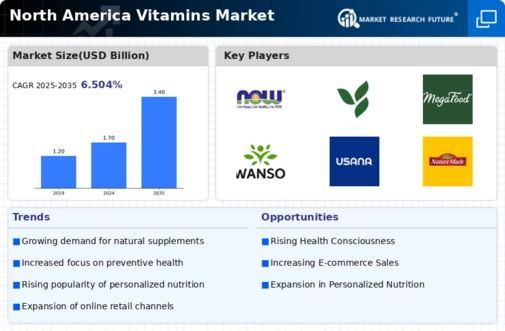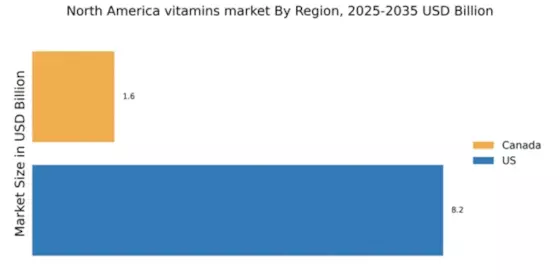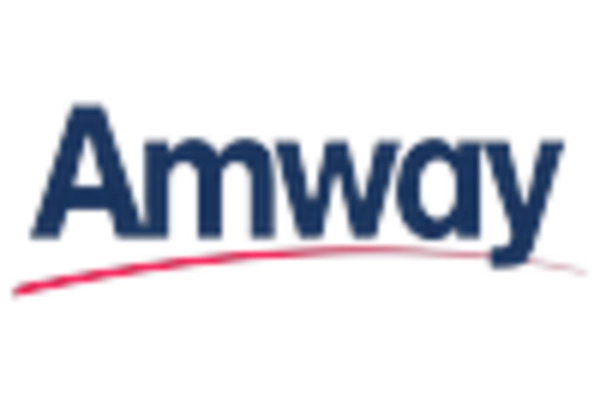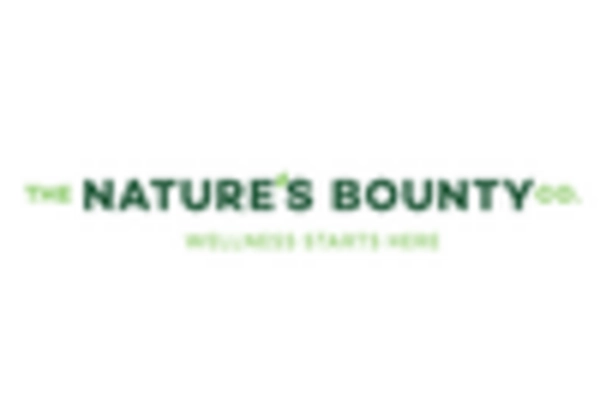The vitamins market exhibits a dynamic competitive landscape characterized by a blend of innovation, strategic partnerships, and a focus on sustainability. Key players such as Herbalife (US), Amway (US), and GNC Holdings (US) are actively shaping the market through diverse strategies. Herbalife (US) emphasizes product innovation and digital marketing, aiming to enhance customer engagement and expand its market share. Meanwhile, Amway (US) focuses on regional expansion and strengthening its supply chain, which appears to bolster its competitive positioning. GNC Holdings (US) is pivoting towards e-commerce and personalized nutrition, reflecting a broader trend in the industry towards tailored health solutions. Collectively, these strategies contribute to a moderately fragmented market structure, where competition is driven by both product differentiation and operational efficiency.
In terms of business tactics, companies are increasingly localizing manufacturing to reduce lead times and enhance supply chain resilience. This approach not only mitigates risks associated with global supply chain disruptions but also aligns with consumer preferences for locally sourced products. The competitive structure remains moderately fragmented, with several players vying for market share, yet the influence of major companies is palpable. Their ability to innovate and adapt to changing consumer demands is likely to dictate market dynamics moving forward.
In October 2025, Herbalife (US) launched a new line of plant-based vitamins, responding to the growing consumer demand for vegan and sustainable products. This strategic move not only diversifies their product portfolio but also positions the company favorably within the health-conscious demographic. The introduction of these products may enhance brand loyalty and attract new customers seeking environmentally friendly options.
In September 2025, GNC Holdings (US) announced a partnership with a leading tech firm to develop an AI-driven personalized nutrition platform. This initiative aims to provide tailored vitamin recommendations based on individual health data, potentially revolutionizing the consumer experience. By leveraging technology, GNC Holdings (US) is likely to enhance customer engagement and retention, setting a new standard in the vitamins market.
In August 2025, Amway (US) expanded its distribution network by entering into a strategic alliance with a prominent e-commerce platform. This collaboration is expected to enhance Amway's online presence and accessibility, catering to the increasing trend of online shopping. Such strategic alliances may prove crucial in capturing a larger share of the digital market, particularly among younger consumers who prioritize convenience.
As of November 2025, the competitive trends in the vitamins market are increasingly defined by digitalization, sustainability, and the integration of advanced technologies such as AI. Strategic alliances are becoming pivotal in shaping the landscape, allowing companies to leverage each other's strengths. Looking ahead, competitive differentiation is likely to evolve from traditional price-based competition towards innovation, technological advancements, and supply chain reliability. Companies that can effectively navigate these trends may secure a competitive edge in an ever-evolving market.


















Leave a Comment